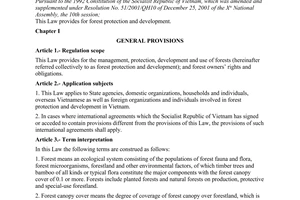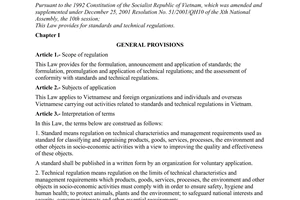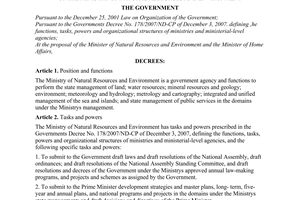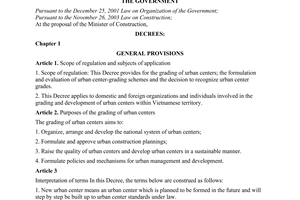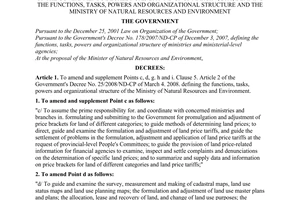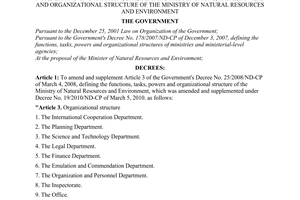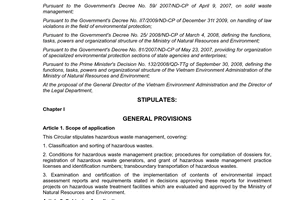Nội dung toàn văn Circular No. 44/2011/TT-BTNMT defining the national technical regulations
|
MINISTRY
OF NATURAL RESOURCES AND ENVIRONMENT |
THE
SOCIALIST REPUBLIC OF VIETNAM |
|
No.: 44/2011/TT-BTNMT |
Hanoi, December 26, 2011 |
CIRCULAR
DEFINING THE NATIONAL TECHNICAL REGULATIONS ON ENVIRONMENT
MINISTER OF NATURAL RESOURCES AND ENVIRONMENT
Pursuant to the Law on Standards and Technical Regulations dated June 29, 2006;
Pursuant to the Decree No.127/2007/ND-CP dated August 01, 2007 of the Government detailing the implementation of some Articles of the Law on Standards and Technical Regulations;
Pursuant to the Decree No.25/2008/ND-CP dated March 04, 2008 of the Government regulating functions, duties, powers and organizational structure of the Ministry of Natural Resources and Environment amended, supplemented at Decree No.19/2010/ND-CP dated March 05, 2010 of the Government and Decree No.89/2010/ND-CP of August 16, 2010 of the Government;
At the request of the General Director of Environment, Director of Department of Science and Technology and Director of the Legal Affairs Department,
REGULATES:
Article 1. To issue together with this Circular the National Technical Regulations on the environment: QCVN 41: 2011/BTNMT - National Technical Regulations on co-processing of hazardous waste in cement kilns.
Article 2. This Circular takes effect as from March 01, 2012.
Article 3. General Director of General Department of Environment and heads of units under the Ministry of Natural Resources and Environment, Directors of Departments of Natural Resources and Environment of provinces and cities directly under the Central Government and other concerned organizations and individuals are responsible for the implementation of this Circular. /.
|
|
FOR
MINISTER |
QCVN 41: 2011/BTNMT
NATIONAL TECHNICAL REGULATIONS ON CO-PROCESSING OF HAZARDOUS WASTE IN CEMENT KILNS
Preamble
QCVN 41: 2011/BTNMT compiled by the group of editors of National Technical Regulations on co-processing of hazardous waste in cement kilns, General Department of Environment, Department of Science and Technology, Department of Legal Affairs submit for approval and issued under Circular No.44/2011/TT-BTNMT dated December 26, 2011 by the Minister of Natural Resources and Environment.
NATIONAL TECHNICAL REGULATIONS
ON CO-PROCESSING OF HAZARDOUS WASTE IN CEMENT KILNS
1. GENERAL PROVISIONS
1.1. Scope of governing
This Regulations specifies the technical requirements for the application of co-processing hazardous waste (hereinafter referred to as HW) in cement kilns.
1.2. Subjects of application
This Regulations only applies to the establishments, lines of cement production applying co-processing hazardous waste in cement kilns (hereinafter referred to as cement establishments of HW co-processing), state management agency on environment and organizations and individuals involved in the co-processing of hazardous waste in cement kilns.
1.3. Interpretation of terms
In this Regulations, the following terms are construed as follows:
1.3.1. Cement kiln (hereinafter referred to as kiln) means a system to convert raw materials into clinker in the cement production establishments, and may include parts of pre-burning, pre-calcification.
1.3.2. Pre-burning or pre-calcification means a process done separately or combined in the same department together with the kiln for drying purpose or calcification of part or whole of raw materials before loaded into the kilns.
1.3.3. HW co-processing in cement kilns (hereinafter referred to as HW co-processing) means a combination of the cement production process for handling hazardous waste, including hazardous waste used as fuel, alternative materials in cement production or be incinerated by temperatures in the kilns.
1.3.4. Pretreatment means the process of preliminary or primary treatment of waste to produce a waste stream which is relatively homogeneous according to certain technical requirements before loading into co-processing.
1.3.5. Industrial gas waste from cement production applied HW co-processing (hereinafter referred to as gas waste from HW co-processing) means a mixture of the material composition emitted to air environment from the major chimney of the kilns and parts of pre-burning, pre-calcification applying HW co-processing (hereinafter referred to as the major chimney).
1.3.6. Nm3 (cubic meters of standard waste gas) means a cubic meter of exhaust gas at a temperature of -25 ° C and pressure of 760 mm Hg.
1.3.7. Kp means a power factor in proportion of a total capacity by design of the cement establishment of HW co-processing.
1.3.8. Kv means the coefficient of the area, region in proportion of locations of establishment of HW co-processing.
1.3.9. P means the total design capacity of cement establishment of HW co-processing.
2. TECHNICAL PROVISIONS
2.1. General requirements for cement establishment of HW co-processing
2.1.1. Required to use technology rotary kiln of dry method.
2.1.2. With locations not in one of the following areas:
2.1.2.1. Inner suburbs, inner city of urban area of special grade, grades I, II, III, IV (as stipulated in Decree No.42/2009/ND-CP dated May 07, 2009 by the Government on the classification of urban city); suburbs with the distance to the inner city boundary of special grade, grade I under 05 km (from the base of the major chimney of the cement establishment of HW co-processing);
2.1.2.2. Specially-used forest areas including national parks; natural preservation areas; landscape protecting areas; forest for research, scientific experiments (as prescribed in the 2004 Law on Protection and Development of Forests);
2.1.2.3. Natural heritage areas, cultural, historic relics ranked (recognized by UNESCO or ranked by the Prime Minister, the governing ministry decided to establish).
2.1.3. Required to take measures to cool the waste gases from the major chimney down below 200 degrees centigrade (<200 ° C) before being discharged into the environment.
2.1.4. Required to have a system for receiving, temporarily storing and loading waste safely, reasonably according to regulations.
2.1.5. Meeting the technical requirements specified in Appendix 7 of Circular No.12/2011/TT-BTNMT dated April 14, 2011 of the Minister of Natural Resources and Environment regulating on HW management (hereinafter referred to as Circular No.12/2011/TT-BTNMT).
2.2. Maximum allowable concentrations of pollution parameters in the emissions of HW co-processing
2.2.1. For parameters of general typical pollution in industrial emissions of cement production applying to the co-processing of HW:
During normal operating conditions, the maximum allowable concentration of the general typical pollution parameters in emissions of HW co-processing is calculated as follows:
Cmax = C x Kp x Kv
Of which:
- Cmax means the maximum allowable concentration of the general typical pollution parameters in emissions of HW co-processing, calculated in milligrams per cubic meter of standard waste gas (mg/ Nm3);
- C means the concentration used as a basis for calculating the maximum allowable concentration (Cmax) of the general typical pollution parameters in emissions of HW co-processing, which are defined in Table 1 of this Regulations;
- Kp is defined in Table 2 of this Regulations;
- Kv is defined in Table 3 of this Regulations.
Table 1: Concentration C used as a basis for calculating the maximum allowable concentration of the general typical pollution parameters
|
No. |
Parameters |
Concentration C (mg/Nm3) |
|
1 |
Total dust |
100 |
|
2 |
CO |
500 |
|
3 |
NOx (calculated by NO2) |
1.000 |
|
4 |
SO2 |
500 |
Table 2: Kp power factor
|
Total capacity by design |
Kp factor |
|
P ≤ 0,6 |
1,2 |
|
0,6 < P ≤ 1,5 |
1,0 |
|
P > 1,5 |
0,8 |
Table 3: Kv coefficient of the area, region
|
Zoning, separating region |
Kv coefficient |
|
|
Type 1 |
Areas where the distance to the boundaries of the specially-used forest areas, natural heritage areas, cultural, historic relics ranked (mentioned in point 2.1.2 of this Regulation) is less than 05 km. |
0.6 |
|
Type 2 |
- Suburban areas where the distance: to the boundary of inner city areas of special grade, grade I is from 05 km or more, or to the inner city areas of grades II, III, IV is less than 05 km; - Areas where the distance to the boundary of suburbs of city of special grade, grade I is less than 05 km. |
0.8 |
|
Type 3 |
Industrial zones and industrial clusters; urban city of grade V; suburbs with the distance to the inner city boundary of grades II, III, IV, is 05 km or more; - Areas where the distance to the boundary of this region, this area is less than 05 km. |
1.0 |
|
Type 4 |
Rural areas outside the above mentioned regions, areas. |
1.2 |
|
Type 5 |
Mountainous rural areas outside t the above mentioned regions, areas. |
1.4 |
|
Note: - The distance specified in this Table 3 is calculated from the base of the major chimney of the cement establishment of HW co-processing; - If the base of the major chimney of the cement establishment of HW co-processing is determined under both 02 types of regions, areas or more, then apply the smallest Kv among the regions and areas. |
||
2.2.2. For particular typical pollution parameters in the exhaust gas of HW co-processing:
During normal operating conditions, the maximum allowable concentrations of the particular typical pollution parameters in the exhaust gas of HW co-processing are defined in Table 4 below.
Table 4: Maximum allowable concentrations of particular typical pollution parameters in the exhaust gas of HW co-processing
|
No. |
Parameters |
Unit |
Maximum allowable concentrations |
|
1 |
HF |
mg/Nm3 |
5 |
|
2 |
HCl |
mg/Nm3 |
50 |
|
3 |
Mercury and its compounds, measured in Hg |
mg/Nm3 |
0,55 |
|
4 |
Cadmium and its compounds, measured in Cd |
mg/Nm3 |
0,16 |
|
5 |
Total other heavy metals: As, Sb, Ni, Co, Cu, Cr, Pb, V, Sn, Mn, Tl, Zn |
mg/Nm3 |
2 |
|
6 |
Total Dioxin/Furan (PCDD/PCDF) |
ng-TEQ/Nm3 |
0,6 |
2.2.3. In addition to parameters defined in Table 1 and Table 4, in the necessary cases at request and at pollution control purposes, the concentration of other pollution parameters are applied as specified in Table 1 of QCVN 19: 2009/BTNMT - National Technical Regulations on industrial emissions for dust and inorganic substances.
3. PROVISIONS FOR OPERATION, OBSERVATION AND MONITORING
3.1. Trial operation
3.1.1. The trial operation shall be conducted in accordance with provisions in Circular No.12/2011/TT-BTNMT.
3.1.2. Where the trial operation of the HW co-processing contains organic halogen beyond threshold specified in QCVN 07: 2009/BTNMT - National Technical Regulations on hazardous waste threshold (hereinafter referred to as QCVN 07: 2009/BTNMT), it must monitor the parameters of Dioxin/Furan as prescribed in Table 4 of this Regulations.
3.2. Requirements for preparation of hazardous waste for co-processing.
3.2.1. Before HW is loaded into co-processing, it must be ensured stably in quality, quantity and calorific value, as well as uniform in size, nature and chemical composition so not affecting the normal operation of kilns, product quality and waste gas. Some requirements for HW prior to loading into co-processing are provided in Appendix 2 of this Regulations.
3.2.2. In case of necessity, HW must be taken pre-treatment to meet the requirements in point 3.2.1 of this Regulations, including measures of preliminary treatment by the single physic-mechanical measure to change the physical properties (such as reduction of size, moisture) or chemical treatment to change its components. The pre-treatment is done inside or outside the cement establishment of HW co-processing.
3.2.3. The different HWs (even in different states of existence) are allowed to mix together or with raw materials, additives, fuel or other waste to meet the requirements in point 3.2.1 of this Regulations, unless it is incompatible with chemical property or might cause adverse effects such as fire, explosion or hazardous gas emissions.
3.2.4. It is mixed waste at a large scale only after conducted successful testing at the laboratory scale.
3.3. Requirements on loading the hazardous waste into co-processing
3.3.1. In addition to the general processes of material loading of cement production, the HW loading into the co-processing must comply with specific requirements as follows:
3.3.1.1. Not to load HW when the kiln is in drying mode during startup process or material loading level is below 75% of the optimum operating level;
3.3.1.2. Not to load waste (hazardous and conventional) containing halogen into the parts of pre-burning or pre-calcification;
3.3.1.3. Not to load organic waste (hazardous and conventional) into the part of pre-burning;
3.3.1.4. Stabilize the HW load level when the kiln is running stably with optimum operational norms.
3.3.2. HW must be loaded in the appropriate positions depending on the nature of each waste stream according to the plans as follows:
3.3.2.1. HW is loaded with separate load line (for liquid hazardous wastes such as waste water required using atomizing faucet);
3.3.2.2. Hazardous waste (solid, liquid, sludge) of non-volatile matter is mixed with raw materials and additives to provide through regular material load;
3.3.2.3. Liquid HW used as alternative fuel is loaded directly or mixed with fuel to refill through the burners;
3.3.2.4. Particularly HWs containing organic halogen components exceeding HW threshold stipulated in QCVN 07: 2009/BTNMT or volatile organic compounds must be loaded into the main burner at the end of the kiln.
3.4. Requirements for kiln stopping process
3.4.1. In case of urgently stopping the kilns, it should stop charging HW before unloading materials and traditional materials and strictly observe process of kiln stopping as prescribed.
3.4.2. Where the kiln is stopped as scheduled, it must unload waste for at least 02 hours before stopping the kiln, switch to use traditional fuel, raw materials and take steps of kiln stopping in accordance with provisions.
3.5. Requirements for observation, monitoring of environment
3.5.1. It must have equipment to observe automatically emissions of HW co-processing for at least two parameters of temperature and CO and other parameters of automatic, continuous observation requested by agencies licensing HW management practice (hereinafter referred to as the licensing agency) depending on the actual situation.
3.5.2. The environmental monitoring is done periodically in accordance with law provisions and at request of the agency approving reports on environmental impact assessment, licensing agencies.
3.5.3. Place of emission sampling on the chimney body and manipulation floor must be arranged to ensure safe and convenient for sampling; not to be sampled at the chimney mouth.
3.5.4. Dioxin/Furan parameters are not required for monitoring except for HW co-processing containing organic halogen components beyond hazardous waste threshold or other necessary cases as requested by the agency to approve the environmental impact assessment report, licensing agencies.
4. METHOD OF DETERMINATION
4.1. Method of determining the concentration of pollution parameters specified in this Regulations shall comply with the following national standards:
- TCVN 5977: 2009 - Emissions of static sources - Determination of mass concentration of dust - the manual method;
- TCVN 6750: 2000 - The static source emissions - Determination of mass concentration of sulfur dioxide – gas ion chromatographic method;
- TCVN 7172: 2002 - The static source emissions - Determination of mass concentration of nitrogen oxides - Photometric method using naphtyletylendiamin;
- TCVN 7242: 2003 – medical solid waste incinerators - the concentration determination method of carbon monoxide (CO) in emission;
- TCVN 7243: 2003 - medical solid waste incinerators - the concentration determination method of hydrofluoric acid (HF) in emission;
- TCVN 7244: 2003 - medical solid waste incinerators - the concentration determination method of hydrochloric acid (HCl) in emission;
- TCVN 7245: 2003 - medical solid waste incinerators - the concentration determination method of nitrogen oxides (NOx) in emission;
- TCVN 7556-1: 2005 - medical solid waste incinerators - Determining the mass concentration of PCDD/PCDF - Part 1: Sampling;
- TCVN 7556-2: 2005 - medical solid waste incinerators - Determining the mass concentration of PCDD/ PCDF - Part 2: Extraction and cleaning;
- TCVN 7556-3: 2005 - medical solid waste incinerators - Determining the mass concentration of PCDDs/ PCDF - Part 3: Qualitative and quantitative;
- TCVN 7557-1: 2005 - medical solid waste incinerators - Determining heavy metals in emission - Part 1: General provisions;
- TCVN 7557-2: 2005 - medical solid waste incinerators - Determination of heavy metals in emission - Part 2: the mercury concentration determination method by atomic absorption spectrometry of cold air;
- TCVN 7557-3: 2005 - medical solid waste incinerators - Determination of heavy metals in emission - Part 3: concentration determination method of cadmium and lead by fire and non-fire atomic absorption spectrometry.
4.2. If there are not national standards to determine the concentration of the pollution parameters defined in this Regulations, then shall apply to international standards with equivalent or higher accuracy.
4.3. Allowed to apply international standards with equivalent or higher accuracy as a substitute for national standards specified in Section 4.1 of this Regulations.
5. Organization of implementation
5.1. Once registered and licensed HW management practice, cement establishments of HW co-processing (other than cement production line not applying the HW co-processing in these establishments or other ancillary parts) must comply with the provisions of this Regulations; not to comply with the provisions in QCVN 23: 2009/BTNMT - National Technical Regulations on industrial emissions of cement production and Clause 2 of Article 11 of Circular No.12/2011/TT- BTNMT (defined on the number of means of transportation).
Cement establishments of HW co-processing that are operating under HW management permits before the effective date of this Regulations shall comply with content specified in the reports on environmental impact assessment approved, the permits that were granted and required to upgrade, make technical adjustments to meet the provisions of this Regulations before January 01, 2014.
5.2. Organizations and individuals research, select the appropriate types of HWs under the guidance in Appendix 1 of this Regulations for the registration of co-processing in cement kilns and make documentation of registration, submit to the licensing agencies for consideration and licensing HW management practice in accordance with provisions.
5.3. The establishments, cement production lines meeting the technical requirements of this Regulations shall be permitted to co-process conventional waste.
5.4. If the legal documents, National Technical Regulations, National Standards referred to in this Regulation are amended, supplemented or replaced, then shall apply the new documents.
5.5. State management agencies on environment are responsible for guiding, inspecting and supervising the implementation of this Regulations.
APPENDIX 1:
SELECTION OF HW FOR
CO-PROCESSING IN CEMENT KILNS
(Together with QCVN 41: 2011/BTNMT -
National Technical Regulations on the co-processing of HW in cement kilns)
1.1. HW capable of co-processing in cement kilns
1.1.1. Hazardous waste used as alternative fuels; including types of HWs with high calorific value as follows:
- Liquid hazardous wastes such as waste oil; waste emulsion; waste organic solvents and paints, waste varnishes ...
- Hazardous waste in solid form such as wax, waste grease; the solid waste containing oil; bituminous mixtures, waste coal tar and tar; cloths; the waste materials (wood, sawdust, paper and cardboard, rubber, plastics, leather, fabric ...) containing hazardous components; adhesives and waste sealants; waste activated carbon; residues of distillation column ...
1.1.2. Hazardous waste used as alternative fuel include the types of hazardous waste containing components suitable for cement production, such as sewage sludge; ash, slag, soot, dust of furnace, ore, clay, stone, sand, waste gypsum containing hazardous constituents; abrasive materials…
1.1.3. HW with purpose only for destroying thank to kiln temperature without using value as fuel or alternative fuels such as mother liquid, suspension, wastewater, waste chemicals (including waste plant protection chemicals); soil contaminated chemicals; waste catalysts; waste ink ...
1.1.4. HW with combination nature from the types referred to in points 1.1.1, 1.1.2 and 1.1.3 of this Appendix, including HW at the same time having the proper components for used as raw materials and fuel; or hazardous waste at the same time having the proper components for used as raw materials or fuel and components only for destruction.
1.2. HW not being co-processed in cement kilns
Except for special cases to be considered specifically by the licensing agencies, the HWs not being co-processed in cement kilns include: infectious hazardous waste or HW containing waste mercury from medical and veterinary sectors; waste containing asbestos; electrical equipment (including battery, accumulator), waste electron not yet been classified, dismantled; explosive wastes; radioactive waste, and other wastes of unknown composition or not yet been unconfirmed, classified (including common waste).
APPENDIX 2:
REQUIREMENTS FOR HAZARDOUS WASTE BEFORE LOADING
INTO CO-PROCESSING IN CEMENT KILNS
(Together with QCVN 41: 2011/BTNMT - National Technical Regulations on the
co-processing of HW in cement kilns)
Except for being operated separate trial and licensing agency considers and grants permission for each specific case, before being loaded into the HW co-processing in cement kilns, HW must meet or be pre-treated to meet requirements on the composition and properties as follows:
|
Parameters |
Unit |
Limit |
|
pH |
- |
4-12 |
|
Cl |
% |
≤ 3 |
|
S |
% |
≤ 3 |
|
F |
% |
≤ 1 |
|
PCB |
ppm |
≤ 500 |
|
As |
ppm |
≤ 100 |
|
Cr |
ppm |
≤ 1,000 |
|
Cu |
ppm |
≤ 1,000 |
|
Hg |
ppm |
≤ 30 |
|
Pb |
ppm |
≤ 1,000 |
|
Sb |
ppm |
≤ 1,000 |
|
TI |
ppm |
≤ 50 |
|
Zn |
ppm |
≤ 15,000 |
ANNEX 3:
REFERENCE DOCUMENTS
(Together with QCVN 41: 2011/BTNMT -
National Technical Regulations on the co-processing of HW in cement kilns)
1. The Law on Environmental Protection, 2005.
2. Law on Standards and Technical Regulations, 2006.
3. Circular No.12/2011/TT-BTNMT dated April 14, 2011 of the Minister of Natural Resources and Environment regulating on hazardous waste management.
4. QCVN 07: 2009/BTNMT - National Technical Regulations on hazardous waste threshold.
5. QCVN 19: 2009/BTNMT - National Technical Regulations on industrial emissions for dust and inorganic substances.
6. QCVN 23: 2009/BTNMT - National Technical Regulations on industrial emissions of cement production.
7. QCVN 30: 2010/BTNMT - National Technical Regulations on emissions of industrial waste incinerators.
8. TCVN 5977: 2009 - Emissions of static sources - Determination of mass concentration of dust by the manual method.
9. TCVN 6750: 2000 - Emissions of static sources - Determination of mass concentration of sulfur dioxide - gas ion chromatographic method.
10. TCVN 7172: 2002 - Emissions of static sources - Determination of mass concentration of nitrogen oxides - Photometric method using naphtyletylendiamin.
11. TCVN 7242: 2003 – Medical solid waste incinerators - the concentration determination method of carbon monoxide (CO) in emission.
12. TCVN 7243: 2003 - medical solid waste incinerators - the concentration determination method of hydrofluoric acid (HF) in emission.
13. TCVN 7244: 2003 - medical solid waste incinerators - the concentration determination method of hydrochloric acid (HCl) in emission.
14. TCVN 7245: 2003 - medical solid waste incinerators - the concentration determination method of nitrogen oxides (NOx) in emission.
15. TCVN 7556-1: 2005 - medical solid waste incinerators - Determining the mass concentration of PCDD/PCDF - Part 1: Sampling.
16. TCVN 7556-2: 2005 - medical solid waste incinerators - Determining the mass concentration of PCDD/ PCDF - Part 2: Extraction and cleaning.
17. TCVN 7556-3: 2005 - medical solid waste incinerators - Determining the mass concentration of PCDDs/ PCDF - Part 3: Qualitative and quantitative.
18. TCVN 7557-1: 2005 - medical solid waste incinerators - Determining heavy metals in emission - Part 1: General provisions.
19. TCVN 7557-2: 2005 - medical solid waste incinerators - Determination of heavy metals in emission - Part 2: the mercury concentration determination method by atomic absorption spectrometry of cold air.
20. TCVN 7557-3: 2005 - medical solid waste incinerators - Determination of heavy metals in emission - Part 3: concentration determination method of cadmium and lead by fire and non-fire atomic absorption spectrometry.
21. Department of Environmental Protection, 2007. Technical Guideline for the co-processing of hazardous wastes in cement kilns.
22. Holcim - GTZ, 2006. Guidelines on Co-processing Waste Materials in Cement Production.
23. Basel Convention, 2011. (Draft) Technical Guidelines on Environmentally Sound Co-processing of Hazardous Waste in Cement Kilns.
------------------------------------------------------------------------------------------------------
This translation is made by LawSoft and
for reference purposes only. Its copyright is owned by LawSoft
and protected under Clause 2, Article 14 of the Law on Intellectual Property.Your comments are always welcomed
